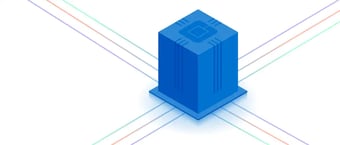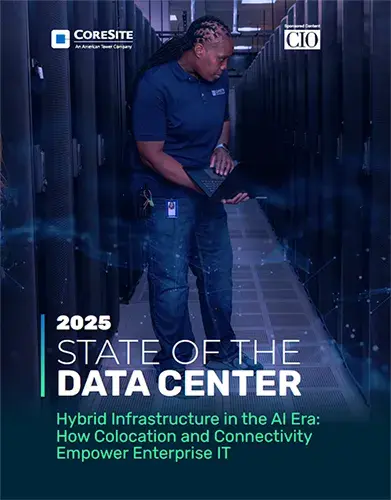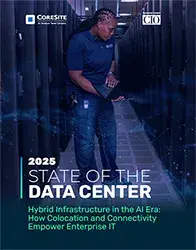
New State of the Data Center Report Highlights Hybrid Infrastructure in the AI Era
IT leaders remain committed to colocation – a stable, secure, resilient and scalable environment for workloads – according to the just-released 2025 State of the Data Center report from CoreSite. The research, conducted by Foundry, shows the expansion of artificial intelligence (AI) is pressuring organizations to reassess their IT infrastructure to balance cost and performance, and colocation data centers are taking on an expanding role in hosting AI as well as other critical workloads.
The 2025 State of the Data Center report: Survey results and interviews with IT decision-makers on strategies for interconnecting AI and other workloads to achieve hybrid IT infrastructure performance, flexibility and cost management goals.
Explore proven strategies for modernizing IT and selecting your data center provider.
Optimizing Workloads Across Hybrid IT Infrastructure
One of the most important findings of the report is an overwhelming shift to hybrid infrastructure. The data shows that almost all IT leaders (98%) have adopted or plan to adopt a hybrid IT model. These organizations are striking a balance between on-prem, colocation and cloud, optimizing workloads across distributed environments to meet their unique needs.
The research also suggests that cloud cost management priorities are driving organizations to repatriate apps and workloads from the cloud back to on-premises data centers. However, many of these apps and workloads are also being migrated to colocation data centers, because IT leaders appreciate colocation’s blend of greater control, lower costs and robust connectivity.
The survey results show colocation facilities are hosting a greater percentage of many different workload types compared to 2024 – ranging from cybersecurity and core business apps to AI and Internet of Things – and many organizations are considering moving even more workloads from public cloud to colo over the next 12 months.
Leveraging Colocation for AI Workloads
With regard to AI specifically, the report shows that organizations are moving an increasing volume of AI workloads to colocation data centers, including generative AI applications (45% in 2025 vs. 42% in 2024), recommendation systems (47% vs. 36%), and augmented AI applications (44% vs. 41%). The primary drivers behind this shift are performance, cost and hybrid flexibility.
Many IT teams are choosing colocation over cloud for AI/ML workloads because of intense performance needs such as high-compute density and low latency. In addition, colocation data centers allow more control over infrastructure placement, network paths and hardware configuration – a level of control that is simply not attainable in the cloud.
Cost is another factor making colocation more practical for AI. Long-term AI deployments in the cloud can result in high, ongoing costs, especially for training and inference at scale. Colocation offers a more predictable cost structure and substantially reduced data egress fees.
This doesn't mean organizations will no longer use cloud for AI workloads, however. A hybrid approach combining cloud and colocation provides the flexibility to run AI workloads where they perform best. Colocation serves as the foundation for AI infrastructure, while allowing IT teams to leverage a variety of cloud-native services.
Interconnection: The Colocation Differentiator
The 2025 State of the Data Center report also highlights the need for hybrid connectivity between on-prem, colo and cloud – and exposes this deficiency in many colocation providers. Most survey respondents consider direct cloud connectivity through colocation a “must have,” citing it as the second most important AI-specific capability they look for in a provider. However, only one in five (19%) say their colocation service offers interconnection to a variety of clouds. And this number has been dropping significantly in recent years – from 31% in 2024 and 36% in 2023.
Colocation providers that deliver varied interconnection options are particularly important for an increasingly popular workload: generative AI (GenAI). GenAI requires hybrid infrastructure orchestration, positioning colocation’s direct cloud interconnects as a pivotal enabler. In the report, cloud interconnection is cited as the top reason to use colocation for GenAI, due to advantages such as reduced egress costs and faster data transfer.
Colocation's Emerging Role in Hybrid IT
Hybrid IT is clearly the future of IT infrastructure, and this year’s survey demonstrates that organizations employing the right mix of on-premises, colocation and public cloud infrastructure will gain a competitive advantage in the age of AI.
The report also confirms colocation's growing role as an essential hub for hybrid IT. Colocation data centers enable hybrid IT models, making them a more compelling option than ever before, but the 2025 State of the Data Center report indicates that choosing the right provider should be a strategic priority. Download the full report to find out about the top attributes IT leaders demand in a colo provider, the top reasons to run GenAI workloads in a colocation data center, and much more about colocation's emerging role in hybrid IT.
Know More
Now in its sixth year, the 2025 State of the Data Center research, conducted by Foundry, surveyed 300 CIOs, CTOs and other IT decision-makers representing a variety of industry sectors. In addition to the online survey, Foundry conducted in-depth interviews with seven senior technology executives from enterprise organizations in the financial services, healthcare, retail and software-as-a-service (SaaS) sectors. Quotes from those interviews are included throughout the report, with the understanding that subjects would not be identified by name or company so they could speak freely about their data center strategies.
Download, read and share the 2025 State of the Data Center report.












